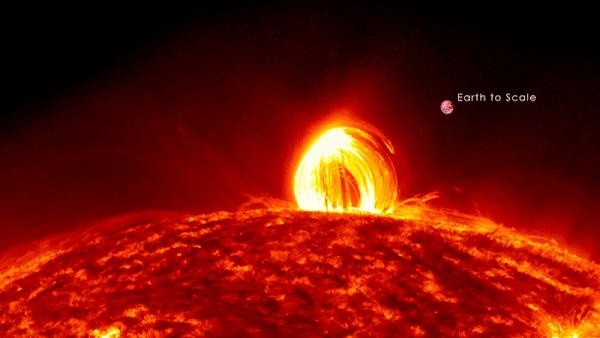Experts said a high-speed solar storm approaching Earth at 1.6 million kilometers per hour is projected to smash our planet's magnetic field soon. It could damage electrical supply and communication infrastructure around the world.
Latestly (via Yahoo! News) said the solar flare, coming from an equatorial hole in the sun's atmosphere initially discovered on July 3, can travel at a maximum speed of 500 kilometers per second. Although full-fledged geomagnetic storms are improbable, minor geomagnetic instability could cause auroras at high latitudes.

Solar Storm Classification
The latest forecast obtained by First Post from the US Space Weather Prediction Centre said the storm could cause a nationwide outage of high-frequency radio transmission for about an hour. The solar flares have been classified as X1 by the Center. The 'X' designating the classification and the number suffix denotes the flare power.
Massive explosions on the sun's surface send energy, light, and high-speed particles into space, known as solar flares. Space.com said the most powerful flares as "X-class flares," based on a classification system that categorizes solar flares according to their severity. A-class includes the smallest, followed by B, C, M, and X. An X-class solar flare is expected to soon hit Earth's magnetic field.
When aimed directly at Earth, the most powerful ones can endanger astronauts and satellites in space and interfere with power grids on Earth. This minor storm in the magnetosphere, according to Outlook, could cause auroras in the north and south latitudinous zones.
ALSO READ : Largest X-Class Solar Flare: Why It is Impossible for "Killer Solar Flare" to Destroy Earth
How Solar Storms Impact Human Health?
Solar storms could generate radiations that are dangerous to people and can cause organ damage, radiation sickness, and cancer if they are exposed to them.
Solar flares pose no major harm to humans on the ground, according to most specialists. This is because the Earth's atmosphere functions as a shield for living things, absorbing the majority of the radiation.
On the other hand, passengers on planes may face some health hazards if they fly during a solar storm. According to studies, pilots are more likely to develop cataracts. Passengers and staff may be exposed to high levels of radioactivity. As a result, planes are occasionally redirected to avoid any radiation exposure caused by solar storms.
Astronauts in space may confront greater danger than those on Earth's surface.
While most experts believe that solar storms do not have a significant impact on human health, some doubt that they are entirely safe. Interactions between geomagnetic disturbances and the autonomic nervous system are likely to induce a cascade of reactions in the body's electrophysiology that culminate in the collapse of organ functions and death, BioMedCentral said.
RELATED ARTICLE : Earth Faces First X Class Flare for Solar Cycle 25; Here's What It Means
Check out more news and information on Space in Science Times.












